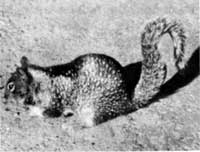Two Interesting Ornithological Observations
During the month of August we recorded two observations which are of considerable interest since they add materially to our knowledge of the avifauna of the Park. On August 23, 1952, a juvenile English Sparrow, Passer domesticus (Linnaeus), was seen near the Information Building at the Rim Village. Since this is considerably out of the altitudinal range and habitat of this species the possibility of this individual having been liberated in the vicinity should not be precluded.
Farner (1952: 167) includes this species in the supplemental list of birds of the Park on the basis of observations by Joseph Dixon in 1945 near the South Boundary.
On August 31, 1952 we saw two Band-tailed Pigeons, Columba fasciata (Say), perched in the dead top of a mountain hemlock at about 7400 feet on Dutton Ridge. This is a particularly significant record since this species was admitted to the Park list (Farner, 1952: 50) solely on the basis of the remains of a single bird found on July 24, 1945 by Joseph Dixon near the head of Castle Creek. This species must still be regarded as a rare straggler in Crater Lake National Park.
References
Dixon, Joseph. 1945. Field notes in the files of the Regional Office of the National Park Service, San Francisco
Farner, Donald S. 1952. The Birds of Crater Lake National Park, University of Kansas Press, Lawrence. ix + 200 pp.
Gray Diggers and Muskrats
An adult male Douglas ground squirrel, Citellus beecheyi douglasii Richardson, was found dead along the west entrance highway about four miles within the park boundary, on July 15, 1952. This animal, also known as the gray digger, was noticed by Art C. Toth, foreman of the fire guards, who brought it to Park Headquarters to be added to our mammal collection (CLNP # 522). Although these ground squirrels have been observed occasionally along the western and southern boundaries of the park, the only other collection was made in 1937 at the south entrance (Walks, 1947:53). Since the previous observations within the park have all been made near the west entrance (4800) feet and the south entrance (4400) feet, the finding of this mature individual, apparently killed by a car, at an elevation of about 5700 feet establishes a new record for Crater Lake National Park.
 Gray Digger |
The gray digger lives principally in sagebrush areas of the Upper Sonoran Zone and open forests of the Transition Zone. Somewhat similar to the silver gray squirrel, Sciurus griseus griseus Ord, which is rare within the Park, the gray digger is distinguished by his less bushy tail and the conspicuous black patch which extends from between the shoulders to the middle of his back. In addition, the silver gray squirrel usually stays fairly high in the trees, while the ground squirrels rarely climb more than a few feet off the ground.
On June 12, 1952 a muskrat (CLNP #519) was found by Chief Ranger L. W. Hallock and Assistant Chief Ranger James W. B. Packard, frozen in a snow bank about twenty-five yards east of the intersection of the north road with the rim drive. Later this year, on July 24, a live muskrat was seen by Rangers Edmund J. Bucknall, John C. Wright, and Merrill H. Newman in the headlights of their car at the Annie Spring traffic circle. These are the most recent of several collections and observations which have been made since 1933 (Walks 1947:73).
Many of these records have been in areas in which it seems unlikely that muskrats, which prefer regions having abundant water, would establish permanent homes. However, the known occurrence of three of these animals within the park in the last two years would lead one to suspect that they have become established in one or more restricted localities (Yocom 1951). Since the natural range of the native muskrats does not extend into this region, the most reasonable explanation as to the origin of these individuals is that they are descendants of animals which were introduced several years ago in the Upper Klamath Lake region for purposes of fur farming (Huestis 1938).
References
Canfield, David H. 1933. Gleamings [sic] of the Chief Ranger. Nature Notes from Crater Lake National Park, 6(1):12.
Huestis, Ralph R. 1938. Muskrats in Crater Lake National Park. Nature Notes from Crater Lake National Park, 11(2):22-23.
Wallis, Orthello L. 1947. A Study of the Mammals of Crater Lake National Park. Unpublished Master’s thesis, Oregon State College, Corvallis. 91 pp.
Yocom, Charles F. 1951. Muskrat Record. Crater Lake Nature Notes, 17: 9.

